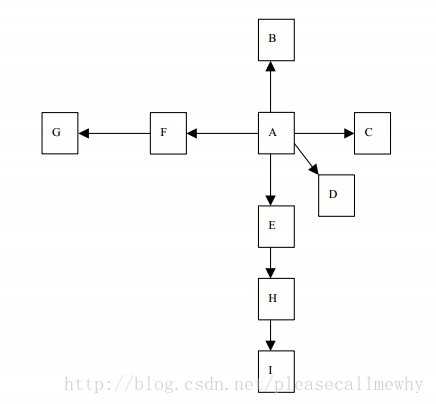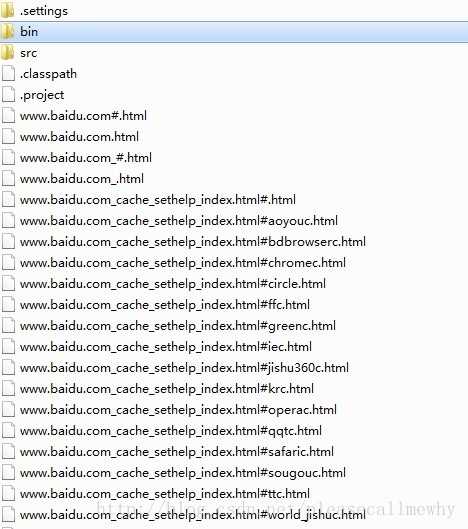标签:
说到爬虫,使用Java本身自带的URLConnection可以实现一些基本的抓取页面的功能,但是对于一些比较高级的功能,比如重定向的处理,HTML标记的去除,仅仅使用URLConnection还是不够的。
在这里我们可以使用HttpClient这个第三方jar包。
接下来我们使用HttpClient简单的写一个爬去百度的Demo:
1 import java.io.FileOutputStream; 2 import java.io.InputStream; 3 import java.io.OutputStream; 4 import org.apache.commons.httpclient.HttpClient; 5 import org.apache.commons.httpclient.HttpStatus; 6 import org.apache.commons.httpclient.methods.GetMethod; 7 /** 8 * 9 * @author CallMeWhy 10 * 11 */ 12 public class Spider { 13 private static HttpClient httpClient = new HttpClient(); 14 /** 15 * @param path 16 * 目标网页的链接 17 * @return 返回布尔值,表示是否正常下载目标页面 18 * @throws Exception 19 * 读取网页流或写入本地文件流的IO异常 20 */ 21 public static boolean downloadPage(String path) throws Exception { 22 // 定义输入输出流 23 InputStream input = null; 24 OutputStream output = null; 25 // 得到 post 方法 26 GetMethod getMethod = new GetMethod(path); 27 // 执行,返回状态码 28 int statusCode = httpClient.executeMethod(getMethod); 29 // 针对状态码进行处理 30 // 简单起见,只处理返回值为 200 的状态码 31 if (statusCode == HttpStatus.SC_OK) { 32 input = getMethod.getResponseBodyAsStream(); 33 // 通过对URL的得到文件名 34 String filename = path.substring(path.lastIndexOf(‘/‘) + 1) 35 + ".html"; 36 // 获得文件输出流 37 output = new FileOutputStream(filename); 38 // 输出到文件 39 int tempByte = -1; 40 while ((tempByte = input.read()) > 0) { 41 output.write(tempByte); 42 } 43 // 关闭输入流 44 if (input != null) { 45 input.close(); 46 } 47 // 关闭输出流 48 if (output != null) { 49 output.close(); 50 } 51 return true; 52 } 53 return false; 54 } 55 public static void main(String[] args) { 56 try { 57 // 抓取百度首页,输出 58 Spider.downloadPage("<a target=_blank href="http://www.baidu.com">http://www.baidu.com</a>"); 59 } catch (Exception e) { 60 e.printStackTrace(); 61 } 62 } 63 }
但是这样基本的爬虫是不能满足各色各样的爬虫需求的。
先来介绍宽度优先爬虫。
宽度优先相信大家都不陌生,简单说来可以这样理解宽度优先爬虫。
我们把互联网看作一张超级大的有向图,每一个网页上的链接都是一个有向边,每一个文件或没有链接的纯页面则是图中的终点:

宽度优先爬虫就是这样一个爬虫,爬走在这个有向图上,从根节点开始一层一层往外爬取新的节点的数据。
宽度遍历算法如下所示:
(1) 顶点 V 入队列。
(2) 当队列非空时继续执行,否则算法为空。
(3) 出队列,获得队头节点 V,访问顶点 V 并标记 V 已经被访问。
(4) 查找顶点 V 的第一个邻接顶点 col。
(5) 若 V 的邻接顶点 col 未被访问过,则 col 进队列。
(6) 继续查找 V 的其他邻接顶点 col,转到步骤(5),若 V 的所有邻接顶点都已经被访问过,则转到步骤(2)。
按照宽度遍历算法,上图的遍历顺序为:A->B->C->D->E->F->H->G->I,这样一层一层的遍历下去。
而宽度优先爬虫其实爬取的是一系列的种子节点,和图的遍历基本相同。
我们可以把需要爬取页面的URL都放在一个TODO表中,将已经访问的页面放在一个Visited表中:

则宽度优先爬虫的基本流程如下:
(1) 把解析出的链接和 Visited 表中的链接进行比较,若 Visited 表中不存在此链接, 表示其未被访问过。
(2) 把链接放入 TODO 表中。
(3) 处理完毕后,从 TODO 表中取得一条链接,直接放入 Visited 表中。
(4) 针对这个链接所表示的网页,继续上述过程。如此循环往复。
下面我们就来一步一步制作一个宽度优先的爬虫。
首先,对于先设计一个数据结构用来存储TODO表, 考虑到需要先进先出所以采用队列,自定义一个Quere类:
1 import java.util.LinkedList; 2 /** 3 * 自定义队列类 保存TODO表 4 */ 5 public class Queue { 6 /** 7 * 定义一个队列,使用LinkedList实现 8 */ 9 private LinkedList<Object> queue = new LinkedList<Object>(); // 入队列 10 /** 11 * 将t加入到队列中 12 */ 13 public void enQueue(Object t) { 14 queue.addLast(t); 15 } 16 /** 17 * 移除队列中的第一项并将其返回 18 */ 19 public Object deQueue() { 20 return queue.removeFirst(); 21 } 22 /** 23 * 返回队列是否为空 24 */ 25 public boolean isQueueEmpty() { 26 return queue.isEmpty(); 27 } 28 /** 29 * 判断并返回队列是否包含t 30 */ 31 public boolean contians(Object t) { 32 return queue.contains(t); 33 } 34 /** 35 * 判断并返回队列是否为空 36 */ 37 public boolean empty() { 38 return queue.isEmpty(); 39 } 40 }
还需要一个数据结构来记录已经访问过的 URL,即Visited表。
考虑到这个表的作用,每当要访问一个 URL 的时候,首先在这个数据结构中进行查找,如果当前的 URL 已经存在,则丢弃这个URL任务。
这个数据结构需要不重复并且能快速查找,所以选择HashSet来存储。
综上,我们另建一个SpiderQueue类来保存Visited表和TODO表:
1 import java.util.HashSet; 2 import java.util.Set; 3 /** 4 * 自定义类 保存Visited表和unVisited表 5 */ 6 public class SpiderQueue { 7 /** 8 * 已访问的url集合,即Visited表 9 */ 10 private static Set<Object> visitedUrl = new HashSet<>(); 11 /** 12 * 添加到访问过的 URL 队列中 13 */ 14 public static void addVisitedUrl(String url) { 15 visitedUrl.add(url); 16 } 17 /** 18 * 移除访问过的 URL 19 */ 20 public static void removeVisitedUrl(String url) { 21 visitedUrl.remove(url); 22 } 23 /** 24 * 获得已经访问的 URL 数目 25 */ 26 public static int getVisitedUrlNum() { 27 return visitedUrl.size(); 28 } 29 /** 30 * 待访问的url集合,即unVisited表 31 */ 32 private static Queue unVisitedUrl = new Queue(); 33 /** 34 * 获得UnVisited队列 35 */ 36 public static Queue getUnVisitedUrl() { 37 return unVisitedUrl; 38 } 39 /** 40 * 未访问的unVisitedUrl出队列 41 */ 42 public static Object unVisitedUrlDeQueue() { 43 return unVisitedUrl.deQueue(); 44 } 45 /** 46 * 保证添加url到unVisitedUrl的时候每个 URL只被访问一次 47 */ 48 public static void addUnvisitedUrl(String url) { 49 if (url != null && !url.trim().equals("") && !visitedUrl.contains(url) 50 && !unVisitedUrl.contians(url)) 51 unVisitedUrl.enQueue(url); 52 } 53 /** 54 * 判断未访问的 URL队列中是否为空 55 */ 56 public static boolean unVisitedUrlsEmpty() { 57 return unVisitedUrl.empty(); 58 } 59 }
上面是一些自定义类的封装,接下来就是一个定义一个用来下载网页的工具类,我们将其定义为DownTool类:
1 package controller; 2 import java.io.*; 3 import org.apache.commons.httpclient.*; 4 import org.apache.commons.httpclient.methods.*; 5 import org.apache.commons.httpclient.params.*; 6 public class DownTool { 7 /** 8 * 根据 URL 和网页类型生成需要保存的网页的文件名,去除 URL 中的非文件名字符 9 */ 10 private String getFileNameByUrl(String url, String contentType) { 11 // 移除 "http://" 这七个字符 12 url = url.substring(7); 13 // 确认抓取到的页面为 text/html 类型 14 if (contentType.indexOf("html") != -1) { 15 // 把所有的url中的特殊符号转化成下划线 16 url = url.replaceAll("[\\?/:*|<>\"]", "_") + ".html"; 17 } else { 18 url = url.replaceAll("[\\?/:*|<>\"]", "_") + "." 19 + contentType.substring(contentType.lastIndexOf("/") + 1); 20 } 21 return url; 22 } 23 /** 24 * 保存网页字节数组到本地文件,filePath 为要保存的文件的相对地址 25 */ 26 private void saveToLocal(byte[] data, String filePath) { 27 try { 28 DataOutputStream out = new DataOutputStream(new FileOutputStream( 29 new File(filePath))); 30 for (int i = 0; i < data.length; i++) 31 out.write(data[i]); 32 out.flush(); 33 out.close(); 34 } catch (IOException e) { 35 e.printStackTrace(); 36 } 37 } 38 // 下载 URL 指向的网页 39 public String downloadFile(String url) { 40 String filePath = null; 41 // 1.生成 HttpClinet对象并设置参数 42 HttpClient httpClient = new HttpClient(); 43 // 设置 HTTP连接超时 5s 44 httpClient.getHttpConnectionManager().getParams() 45 .setConnectionTimeout(5000); 46 // 2.生成 GetMethod对象并设置参数 47 GetMethod getMethod = new GetMethod(url); 48 // 设置 get请求超时 5s 49 getMethod.getParams().setParameter(HttpMethodParams.SO_TIMEOUT, 5000); 50 // 设置请求重试处理 51 getMethod.getParams().setParameter(HttpMethodParams.RETRY_HANDLER, 52 new DefaultHttpMethodRetryHandler()); 53 // 3.执行GET请求 54 try { 55 int statusCode = httpClient.executeMethod(getMethod); 56 // 判断访问的状态码 57 if (statusCode != HttpStatus.SC_OK) { 58 System.err.println("Method failed: " 59 + getMethod.getStatusLine()); 60 filePath = null; 61 } 62 // 4.处理 HTTP 响应内容 63 byte[] responseBody = getMethod.getResponseBody();// 读取为字节数组 64 // 根据网页 url 生成保存时的文件名 65 filePath = "temp\\" 66 + getFileNameByUrl(url, 67 getMethod.getResponseHeader("Content-Type") 68 .getValue()); 69 saveToLocal(responseBody, filePath); 70 } catch (HttpException e) { 71 // 发生致命的异常,可能是协议不对或者返回的内容有问题 72 System.out.println("请检查你的http地址是否正确"); 73 e.printStackTrace(); 74 } catch (IOException e) { 75 // 发生网络异常 76 e.printStackTrace(); 77 } finally { 78 // 释放连接 79 getMethod.releaseConnection(); 80 } 81 return filePath; 82 } 83 }
在这里我们需要一个HtmlParserTool类来处理Html标记:
1 package controller; 2 import java.util.HashSet; 3 import java.util.Set; 4 import org.htmlparser.Node; 5 import org.htmlparser.NodeFilter; 6 import org.htmlparser.Parser; 7 import org.htmlparser.filters.NodeClassFilter; 8 import org.htmlparser.filters.OrFilter; 9 import org.htmlparser.tags.LinkTag; 10 import org.htmlparser.util.NodeList; 11 import org.htmlparser.util.ParserException; 12 import model.LinkFilter; 13 public class HtmlParserTool { 14 // 获取一个网站上的链接,filter 用来过滤链接 15 public static Set<String> extracLinks(String url, LinkFilter filter) { 16 Set<String> links = new HashSet<String>(); 17 try { 18 Parser parser = new Parser(url); 19 parser.setEncoding("gb2312"); 20 // 过滤 <frame >标签的 filter,用来提取 frame 标签里的 src 属性 21 NodeFilter frameFilter = new NodeFilter() { 22 private static final long serialVersionUID = 1L; 23 @Override 24 public boolean accept(Node node) { 25 if (node.getText().startsWith("frame src=")) { 26 return true; 27 } else { 28 return false; 29 } 30 } 31 }; 32 // OrFilter 来设置过滤 <a> 标签和 <frame> 标签 33 OrFilter linkFilter = new OrFilter(new NodeClassFilter( 34 LinkTag.class), frameFilter); 35 // 得到所有经过过滤的标签 36 NodeList list = parser.extractAllNodesThatMatch(linkFilter); 37 for (int i = 0; i < list.size(); i++) { 38 Node tag = list.elementAt(i); 39 if (tag instanceof LinkTag)// <a> 标签 40 { 41 LinkTag link = (LinkTag) tag; 42 String linkUrl = link.getLink();// URL 43 if (filter.accept(linkUrl)) 44 links.add(linkUrl); 45 } else// <frame> 标签 46 { 47 // 提取 frame 里 src 属性的链接, 如 <frame src="test.html"/> 48 String frame = tag.getText(); 49 int start = frame.indexOf("src="); 50 frame = frame.substring(start); 51 int end = frame.indexOf(" "); 52 if (end == -1) 53 end = frame.indexOf(">"); 54 String frameUrl = frame.substring(5, end - 1); 55 if (filter.accept(frameUrl)) 56 links.add(frameUrl); 57 } 58 } 59 } catch (ParserException e) { 60 e.printStackTrace(); 61 } 62 return links; 63 } 64 }
最后我们来写个爬虫类调用前面的封装类和函数:
1 package controller; 2 import java.util.Set; 3 import model.LinkFilter; 4 import model.SpiderQueue; 5 public class BfsSpider { 6 /** 7 * 使用种子初始化URL队列 8 */ 9 private void initCrawlerWithSeeds(String[] seeds) { 10 for (int i = 0; i < seeds.length; i++) 11 SpiderQueue.addUnvisitedUrl(seeds[i]); 12 } 13 // 定义过滤器,提取以 <a target=_blank href="http://www.xxxx.com">http://www.xxxx.com</a>开头的链接 14 public void crawling(String[] seeds) { 15 LinkFilter filter = new LinkFilter() { 16 public boolean accept(String url) { 17 if (url.startsWith("<a target=_blank href="http://www.baidu.com">http://www.baidu.com</a>")) 18 return true; 19 else 20 return false; 21 } 22 }; 23 // 初始化 URL 队列 24 initCrawlerWithSeeds(seeds); 25 // 循环条件:待抓取的链接不空且抓取的网页不多于 1000 26 while (!SpiderQueue.unVisitedUrlsEmpty() 27 && SpiderQueue.getVisitedUrlNum() <= 1000) { 28 // 队头 URL 出队列 29 String visitUrl = (String) SpiderQueue.unVisitedUrlDeQueue(); 30 if (visitUrl == null) 31 continue; 32 DownTool downLoader = new DownTool(); 33 // 下载网页 34 downLoader.downloadFile(visitUrl); 35 // 该 URL 放入已访问的 URL 中 36 SpiderQueue.addVisitedUrl(visitUrl); 37 // 提取出下载网页中的 URL 38 Set<String> links = HtmlParserTool.extracLinks(visitUrl, filter); 39 // 新的未访问的 URL 入队 40 for (String link : links) { 41 SpiderQueue.addUnvisitedUrl(link); 42 } 43 } 44 } 45 // main 方法入口 46 public static void main(String[] args) { 47 BfsSpider crawler = new BfsSpider(); 48 crawler.crawling(new String[] { "<a target=_blank href="http://www.baidu.com">http://www.baidu.com</a>" }); 49 } 50 }
运行可以看到,爬虫已经把百度网页下所有的页面都抓取出来了:

以上就是java使用HttpClient工具包和宽度爬虫进行抓取内容的操作的全部内容,稍微复杂点,小伙伴们要仔细琢磨下哦,希望对大家能有所帮助
标签:
原文地址:http://www.cnblogs.com/shirui/p/5137238.html